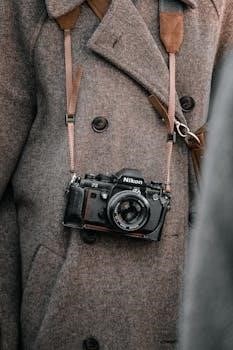Nikon N80 Camera Manual Overview
The Nikon N80, also known as the F80 in some regions, is a 35mm film camera. This overview will guide you through its comprehensive manual. The manual provides essential details for both new and experienced users. It covers key aspects such as camera setup and basic operations. The manual is an invaluable resource for understanding the camera’s features. It offers guidance on troubleshooting common issues and advanced functions.
The Nikon N80, a popular 35mm film SLR camera, represents a significant step in the evolution of photography. This camera, known as the F80 in some markets, is designed for both amateur enthusiasts and semi-professional photographers. It offers a blend of robust build quality and advanced features. The N80 is known for its user-friendly interface and versatile functionality, making it accessible to a wide range of users. This camera provides a gateway to the world of film photography. It’s a valuable tool for learning photographic techniques. Its features allow for creative control over image capture. The Nikon N80 is a dependable camera that allows users to explore the nuances of film. It combines traditional photographic methods with modern conveniences. The camera is celebrated for its ergonomic design and reliable performance. It has a diverse range of settings and shooting modes. This introduction sets the stage for a comprehensive understanding of the camera’s capabilities. Its manual is a vital resource for fully utilizing its features. The N80’s legacy makes it a favored choice among film photography enthusiasts.
Availability of the Nikon N80 Manual
Accessing the Nikon N80 manual is crucial for understanding its functions and features. Several online resources provide the manual in PDF format. These include websites dedicated to camera manuals and photography archives. These sites often offer free downloads of the manual. Users can easily obtain the manual via a direct link. Many websites are dedicated to providing access to these manuals. A simple online search will reveal numerous options. The manual is available for download and viewing. It is found in various digital archives. These archives are maintained by photography enthusiasts. It is also available from communities supporting film photography. Downloading the manual is straightforward from various platforms. It allows users to have a digital copy for reference. The manual is typically found in PDF format. This makes it viewable on computers, tablets, and smartphones. Having the manual on hand is essential for troubleshooting and optimal use. It provides detailed instructions and illustrations. The manual is easily accessible to all N80 users. This ensures that everyone can fully utilize their camera.
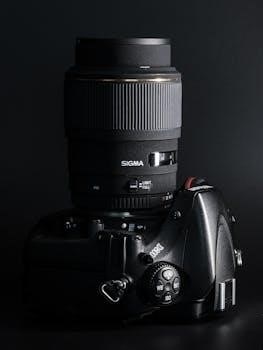
Key Features and Functions
The Nikon N80 boasts several key features. These include various shooting modes, autofocus capabilities, and exposure controls. Its functions cover film loading, rewinding, and settings adjustments. Understanding these elements is critical for effective use. This section delves into these core aspects.
Basic Operations and Settings
The Nikon N80’s basic operations begin with understanding its power source; specifically, how to install the batteries correctly. The manual will guide you through this fundamental step. Familiarizing yourself with the main dial is crucial for selecting shooting modes such as aperture priority, shutter priority, or program mode. Additionally, the manual explains how to navigate the camera’s menus to adjust settings like ISO and exposure compensation. Learning to use the focus mode selector and the various autofocus points is essential for sharp images. The camera also offers a built-in flash, which can be activated or deactivated as needed. Understanding how to set the date and time on the optional quartz data back is also covered. The manual provides clear instructions on using the exposure lock for tricky lighting situations. It also details how to use the self-timer for group shots or self-portraits. These basic settings form the foundation for mastering the Nikon N80 and achieving optimal results.
Film Loading and Rewinding
Proper film loading is crucial for the Nikon N80. The manual details the steps, beginning with opening the camera back. You’ll then learn how to correctly position the film canister and thread the film leader onto the take-up spool. It’s essential to ensure the film lies flat across the film plane. The camera will automatically advance to the first frame. The manual also explains how to monitor the film counter. Rewinding the film is equally important. When finished, the camera can automatically rewind the film, or it can be manually initiated. The manual explains how to manually rewind if necessary. It also addresses how to handle partially exposed film if needed. Knowing how to safely remove the film canister is also critical to prevent accidental exposure. By following these instructions carefully, you can avoid common problems associated with film loading and rewinding, ensuring your images are captured correctly. This section of the manual will help you confidently handle the film aspect of your Nikon N80.
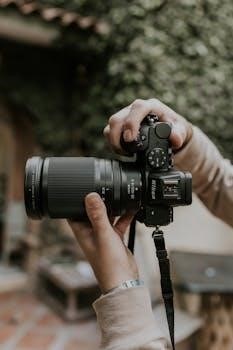
Troubleshooting and Maintenance
This section addresses common issues with the Nikon N80. It includes guidance on battery replacement, and also solutions for other typical problems. The manual helps users maintain their camera. It offers practical advice on routine checks and necessary repairs. This ensures the camera’s optimal performance.
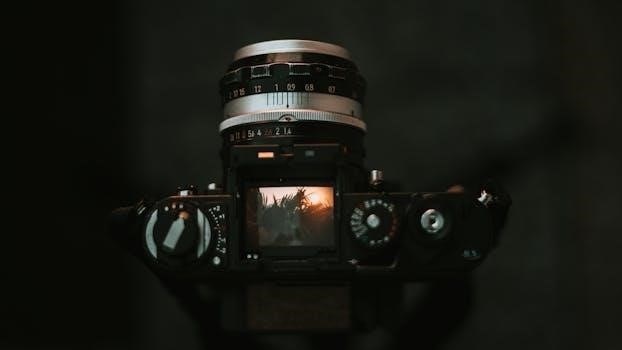
Battery Replacement Guide
The Nikon N80 uses two CR123A lithium batteries, which are essential for powering the camera’s various functions. When your camera displays low battery indicators or starts to malfunction, it’s time for a battery replacement. To replace the batteries, first locate the battery compartment, usually found on the bottom of the camera body. Open the compartment by sliding or flipping the latch. Remove the old batteries, noting their polarity, and insert the new CR123A batteries, making sure to align the positive (+) and negative (-) terminals correctly. Close the battery compartment securely. After replacing the batteries, it’s a good idea to test the camera. Make sure it powers on properly and all functions are working. If you encounter issues after changing the batteries, recheck the polarity and ensure the batteries are fresh. Regularly inspect the battery compartment for any signs of corrosion. This will ensure the long-term performance of the camera. Proper battery handling is critical to avoid any operational problems with your Nikon N80.
Common Issues and Solutions
The Nikon N80, like any other camera, may encounter a few common issues. One frequent problem is the failure to rewind the film completely, which can occur due to mechanical issues or low battery power; To address this, ensure your batteries are fresh and try rewinding again. If the issue persists, consult the manual for manual rewinding instructions. Another issue users face is an unresponsive LCD screen, often caused by low batteries or a damaged connection. Check the batteries first, and if that doesn’t solve the issue, you might need to have it checked by a technician. A malfunctioning exposure meter is also reported, and that can affect the quality of your photos. This can be due to a faulty sensor or dirty contacts. Cleaning the contact points or resetting the camera settings might help. If these solutions don’t work, professional repair may be necessary. Always refer to the manual for detailed troubleshooting steps.
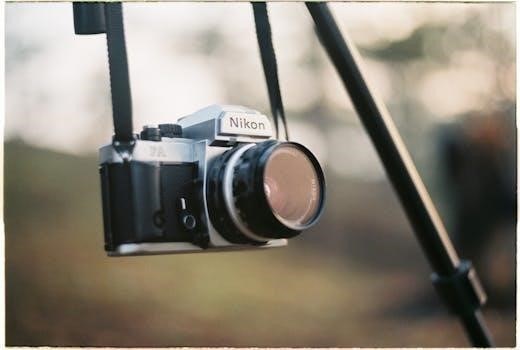
Advanced Features and Accessories
The Nikon N80 offers advanced features for experienced photographers. External flash units provide enhanced lighting options. The camera is also compatible with various lenses. Understanding these options expands creative possibilities. The manual details each accessory’s use. It helps users maximize the camera’s potential.
Using External Flash Units
The Nikon N80, a versatile 35mm film camera, greatly benefits from the use of external flash units. These units, such as the SB-800, expand the camera’s lighting capabilities beyond the built-in flash. The manual provides a detailed guide on how to properly attach and configure external flashes. It explains how to synchronize the flash with the camera’s shutter, ensuring accurate exposure. Furthermore, the manual covers different flash modes, including TTL (Through-The-Lens) metering, which optimizes flash output based on the scene’s light. Users can learn about various settings for controlling flash intensity and achieving specific lighting effects. Understanding these features enables photographers to create well-lit and dynamic images, even in challenging environments. The manual also emphasizes the importance of proper battery management for external flash units, which require their own power source. Connecting the SB-800 or similar flashes to the N80 opens up new creative avenues for film photography. This section of the manual is key for those looking to master advanced lighting techniques.
Lens Compatibility and Usage
The Nikon N80, a popular 35mm film camera, offers compatibility with a wide range of Nikon lenses. Understanding lens compatibility is crucial for maximizing the camera’s potential. The manual details which Nikon lenses are fully compatible with the N80’s autofocus and metering systems. It explains the differences between various lens types, including AF (autofocus) and manual focus lenses. Users will find information on how to properly attach and detach lenses, ensuring they are securely mounted. The manual also highlights the importance of lens coatings and their impact on image quality. It covers how focal length and aperture settings affect the final image. Additionally, the guide emphasizes the need for clean lenses to maintain optimal performance. It also provides guidance on choosing the right lens for different photographic scenarios, such as portraits, landscapes, and action shots. This section is essential for any N80 user looking to explore the full range of photographic possibilities available with different lenses.
